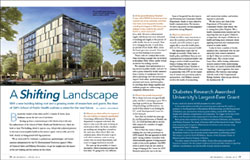A Shifting Landscape
With a new building taking root and a growing roster of researchers and grants, the dean of GW's School of Public Health outlines a vision for the near future.
Beyond the window of her office on D.C.'s frenetic K Street, Lynn Goldman can see the slow rise of the future.
Inching up from a construction pit a few blocks away is the new, $75-million home of the School of Public Health and Health Services, which she leads as dean. The building, slated to open in 2014, will provide a physical presence to the lone school of public health in the nation's capital. And its walls, yet to be built, already are being pinned with big aspirations.
We sat down with Dr. Goldman—a pediatrician, epidemiologist, and former assistant administrator for the U.S. Environmental Protection Agency's Office of Chemical Safety and Pollution Prevention—to get her insights into the impact of the new building and her outlook for the school.
Q: What do you think will be the impact of the new building on research, specifically?
Generating collaboration. Having each department in separate real estate, the way it is now, is not the same as having an environment where the faculty members are teaching and doing their research in the same area, where there's flow into common areas, where it's easier to go to each other's seminars, easier to set up centers that cut across departments, and easier to engage students in research.
You open up the possibility of chance encounters, which sometimes produce the best ideas. It's going to be very different.
Q: At the groundbreaking President Knapp called SPHHS the fastest-growing research arm at the university, and there have been some big grants recently—including the biggest in GW history (see sidebar). Is this a shift for the school? And if so, what's behind it?
It is a shift. We were a school started largely with faculty who were dedicated to teaching and, largely, to the practice of public health, but not to research. Now we're changing the mix. Overall about 40 percent of our faculty effort, across the board, goes into research. Over time I can see that building to 60 percent.
There's a bit of a catalysis that occurs when you bring in people who are involved in disciplines where, before, maybe we had an interest but nothing concrete.
For example, food and nutrition is a big interest in public health. And now we have a group formed by faculty members from a variety of standpoints: how it affects physiology; how the environment impacts food safety; epidemiology, like nutrition and cancer; and food policy. So you bring these things together and suddenly people are collaborating on a completely different level.

The 115,000-square-foot home of GW's School of Public Health is slated to open in 2014.
Q: Where's the growth happening?
We've always been very strong in health policy and that's continuing to grow. We've seen large growth in our Department of Epidemiology and Biostatistics, too, much of that related to our leading the D.C.-wide Developmental Center for AIDS Research.
Since that was funded two years ago [by the National Institutes of Health], the D.C. D-CFAR has been able to successfully compete for a number of supplemental awards.
Part of what the center is doing is building this city-wide powerhouse of AIDS research. But one approach we developed—having academic researchers work with local health agencies to bring research results to bear on the epidemic—the NIH loved so much it has put our center in charge of helping all the Centers for AIDS Research nationwide start to do this.
Some of the growth has also been in our Prevention and Community Health Department, thanks to areas related to health communications. For instance, we have a big project on teen pregnancy prevention among Hispanics.
Q: What's on the horizon?
I think we will see more movement in areas like nutrition and food-related research, and we'll continue to grow organically in areas like health policy, HIV/AIDS, and environmental health.
Two department chairs that we brought on recently—Paula Lantz, in health policy, and Melissa Perry, in environmental and occupational health—are doing so much to build research here. Paula is working with the Clinical and Translational Science Institute at Children's National Medical Center [run in partnership with GW] on the translation of science into prevention policies and practices. And Melissa's research involves the health of meatpacking and construction workers, and workers exposed to pesticides.
We also have a new chair of the Department of Prevention and Community Health, Rajiv Rimal, who is coming from Johns Hopkins. He's a health communications scientist and I'm expecting that area to grow. I think it's so important, the impact of behavior on health and being more systematic about applying behavioral and communication sciences to public health.
Lastly we have a number of faculty members who could mesh with the new university-wide research initiatives (see News, Institutional Knowledge). Many are involved in women's health issues. Plus a recent recruit, Lance Price, will be leading collaborative research aimed at better understanding the source and spread of potentially deadly "superbugs," micro-organisms that resist antibiotics. His work has some synergy with the work of the Computational Biology Institute, when you get down to the fundamentals.
Diabetes Research Awarded University's Largest-Ever Grant
It was a heck of a start to the fall semester for John Lachin.
In the weeks before and after the school year got underway Dr. Lachin, a professor in the Department of Biostatistics & Epidemiology and the Department of Statistics, was awarded two federal grants totaling nearly $150 million for studies into diabetes complications and treatments. The bigger of the two—$134 million over five years—is the largest grant in the history of the university.
Both grants were awarded by the National Institute of Diabetes and Digestive and Kidney Diseases. The larger of the two will fund the launch of a major clinical trial comparing the long-term effectiveness of the four most common drug treatments for type 2 diabetes.
Dr. Lachin is serving as senior biostatistician and is helping to lead GW's Biostatistics Center in its role as the study's nationwide coordinating center. The study is co-led by David M. Nathan, director of the Diabetes Center at Massachusetts General Hospital, in Boston.
The other award, of nearly $14 million, funds a five-year continuation of long-term research into the impact of glucose levels and other factors in spurring diabetic complications, and the benefits of early, intensive treatment.

